A remote planet potentially covered entirely by a deep ocean of water has been identified by astronomers, marking a significant step forward in the quest for habitable environments outside of Earth.
Utilizing NASA’s James Webb Space Telescope (JWST), scientists have detected water vapor, methane, and carbon dioxide in the exoplanet’s atmosphere. Located around 70 light years away and with a radius twice that of Earth, this celestial object exhibits a chemical composition indicative of a water-dominated world surrounded by a hydrogen-rich atmosphere. Despite these promising characteristics, experts from the University of Cambridge advise against picturing it as a tropical paradise.
Professor Nikku Madhusudhan, leading the research, proposes that the ocean’s temperature could surpass 100 degrees Celsius. Even with high atmospheric pressure, sustaining the ocean in a liquid state at such high temperatures raises doubts about its habitability.
The Canadian research team challenges the interpretation published in the journal Astronomy and Astrophysics Letters. They argue that the temperatures on TOI-270 d, an exoplanet, would be too extreme for liquid water, potentially reaching a scorching 4,000 degrees Celsius. Instead, they propose a different scenario where the planet has a rocky surface beneath an immensely dense atmosphere composed of hydrogen and water vapor.
Despite the differing interpretations, the recent observations made possible by the James Webb telescope provide significant insights into the characteristics of planets beyond our solar system. By analyzing starlight that has passed through the atmospheres of these distant worlds, astronomers gain a comprehensive understanding of their chemical compositions, which in turn sheds light on the potential habitability of these alien environments.
The hypothesis suggesting an oceanic world is supported by the absence of ammonia in the atmosphere of TOI-270 d. Basic chemistry principles would predict the presence of ammonia in a hydrogen-rich atmosphere. However, since ammonia is highly soluble in water, its absence in the atmosphere could indicate the existence of an ocean beneath the hydrogen-rich veil. Professor Madhusudhan refers to this scenario as a “hycean” world, characterized by a water ocean beneath a hydrogen-dominated atmosphere.
The conditions on TOI-270 d present a stark contrast to those found on Earth. This exoplanet is tidally locked, meaning that one side is constantly facing its parent star while the other remains in perpetual darkness. As a result, extreme temperature differences are experienced on the planet.
Professor Björn Benneke, a researcher from the University of Montreal, challenges the “hycean world” hypothesis by suggesting that the temperatures on TOI-270 d would be too high for liquid water to exist. His observations indicate surface temperatures that could reach up to 4,000 degrees Celsius, potentially causing water to exist in a supercritical state where the line between liquid and gas becomes blurred.
Both research teams involved in the study have detected the presence of carbon disulphide, a molecule associated with biological processes on Earth. However, it is important to note that the presence of this molecule does not definitively indicate the existence of life on TOI-270 d. Further investigations are necessary to determine the abundance of water vapor in the planet’s atmosphere and to clarify the possibility of an ocean on this distant exoplanet.
Dr. Jo Barstow, an astronomer from the Open University, emphasizes the significance of these observations and highlights the need for additional research to better understand the unique environments of these distant planets. These exoplanets, such as TOI-270 d, offer a valuable opportunity to expand our knowledge as they present environments that are unlike anything found in our own solar system.
Do not forget to share your opinion with us to provide you with the best posts !




0 Comments